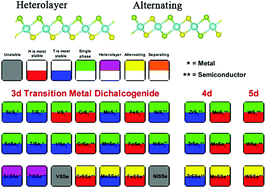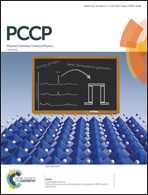Structural stability and intriguing electronic properties of two-dimensional transition metal dichalcogenide alloys†
Abstract
Based on the first-principles calculations, we systematically studied the structures and electronic properties of two-dimensional (2D) transition metal dichalcogenide (TMD) alloys with half-to-half mixing of S and Se. Using the chemical potentials of S and Se, the energetic phase diagrams for both single phases and mixed phases of TMD were constructed. A new heterolayer structure (for Sc and Ti) and alternating structure (for Cr, Mn, Fe, Zr, Mo, and W) were proposed for the first time, which were thermodynamically stable for MSSe alloys under the S-poor (relatively low chemical potential of S) and Se-rich (relatively high chemical potential of Se) conditions, and further compared with the disordered structures. Moreover, band gaps, carrier effective mass, and work functions were calculated for these stable mixed phases. Compared to the single phases of MS2 and MSe2, MSSe alloys showed superior electronic properties including tunable band gaps and work functions. Importantly, the significantly reduced effective mass of the carriers in the MSSe alloys may induce higher carrier mobility, providing better performance of TMD materials in electronic devices.



 Please wait while we load your content...
Please wait while we load your content...